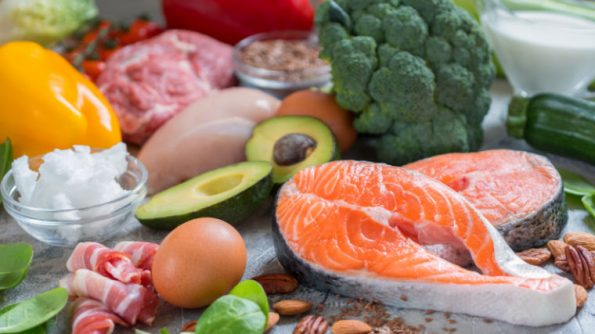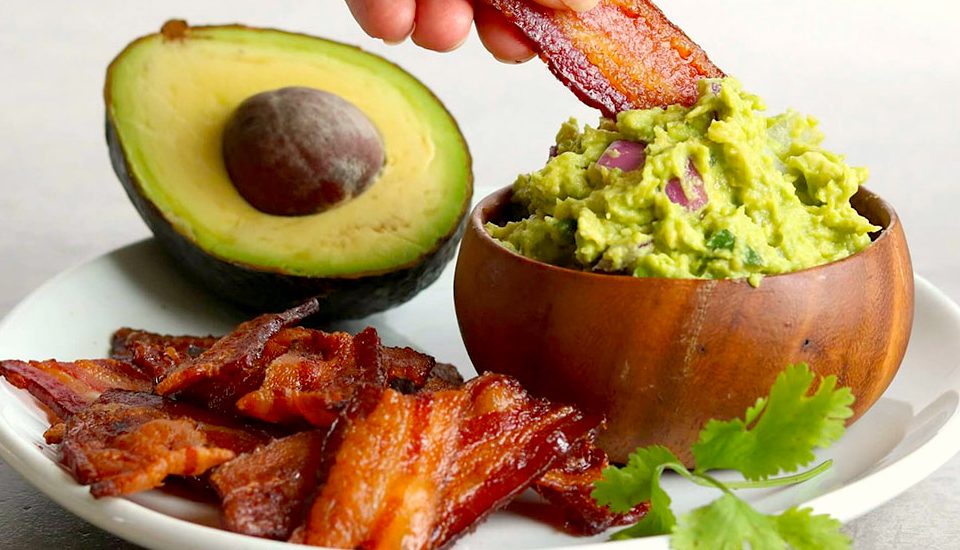The keto (short for ketogenic) diet is everywhere. Although not a new dietary philosophy, it has returned with new vigor. It’s the craze that’s got celebrities downing butter, bacon and bone broth like it’s going out of style….and has caused some people to form unnatural bonds with their avocados….

But what’s the deal with Keto anyway?
To understand how the keto diet works, you need a little background on how the body works.
The human body primarily runs on an energy source called glucose. Glucose is the simplest form of sugar and it is the result of digested carbohydrates (carbs…gasp!). We get carbohydrates from food sources such as: whole grains, fruits, starchy vegetables like potatoes and sweets.
Over the course of history, our bodies have got really good at using carbs as fuel and we can store about 2-3 days’ worth of glucose in our liver and muscles.
However, if you were to starve yourself of carbohydrates for the course of 2-3 days your body would need to find a different source of fuel to keep it going. In these types of conditions, your body can turn to ketone bodies (ketones for short) as its primary fuel source; this is called ketogenesis.
Ketones are produced during ketogenesis as the body’s liver begins to breakdown fat for energy. Once the level of ketones begins to rise in the blood, the body enters a state called “ketosis”, where the body begins to burn stored body fat directly.
This state called ketosis is what is pursued by proponents of the ketogenic diet, for its potential health benefits and implications for chronic disease. Getting to this “magical” state involves starving yourself completely…. or consuming an extremely high-fat diet, with max 20-50g of carbohydrates per day. For reference, 50g of carbs isn’t much, about 2 slices of bread or 2 large potatoes.
What does the Keto diet actually look like?
Say goodbye to that bread and the rest of the grains, as well as all dairy, beans, fruit and sweets. Get ready to get reacquainted with meats, eggs, cheese, fish, nuts, butter, fatty oils, and non-starchy vegetables. Keeping your intake of carbs down and your blood ketones high means really staying vigilant and carefully avoiding foods that contain carbs. For example, a typical dinner could consist of pan fried salmon, zucchini noodles and broccoli in a rich cream sauce. Sure, you’d miss garlic fingers, but that doesn’t sound so bad does it?

So the food isn’t bad, and I’ll be losing a ton of weight and preventing diabetes, right?
Well…the research on diabetes is only preliminary, but studies have been showing significant decreases in A1C% (marker used to assess blood sugar control) and medication usage in people following a keto diet. The findings are impressive; however, they have only been reported in a handful of studies, and some of those were funded by ketogenic advocates…so the research is promising, but not quite there yet.
Where there is a ton of research, is on the ketogenic diet’s ability to prevent seizures in children with medication resistant epilepsy. The therapeutic implications for this diet have been seen since the 1920’s and it is still successfully used today to treat certain patients with epilepsy.
Okay, will I lose weight though?
Weight loss is complicated. The diet works on the premise that by reducing carb intake you are therefore reducing the body’s insulin response, suppressing hunger, boosting your metabolism, reducing inflammation and burning stored fat directly. The entire premise is still theoretical and has not been proven, despite the obnoxious anecdotes of success that occupy every dark corner of the web.
What the research shows is that there is a rapid weight loss upon starting the diet, as the body adapts to a high fat/very low carb diet from a traditional diet. The reason for this rapid weight loss is due to a loss of water. When carbs are stored in our body they are stored with a large amount of water. As the body uses up its stored carbs, it releases the water, and since there is no more carbs coming in, the water is excreted and body weight drops. The numbers on the scale may be dropping, but that’s not fat you’re losing; it’s just good ol’ H2O.
Diets high in protein and fat have been shown to decrease appetite and people often are more satisfied with less food than people on traditional diets. Eating less food automatically reduces the number of calories consumed, which can lead to a greater weight loss through a keto diet. However, fat contains twice as many calories per gram than carbs, and so the calories can creep up quickly. Even on the keto diet, eating less calories than you’re burning is still required for weight loss.
Hard truths
The more restrictive the diet, the harder it is to stick to, and the keto diet is extremely restrictive, eliminating 2 entire food groups. Restricting large amounts of food, causes you to adopt a completely new lifestyle. You will be cooking a lot, and enjoying food with friends and family will be much more complicated than it was before. Restricting foods can also trigger dysfunctional eating patterns in certain people and lead to eating disorders.
However, weight loss is certainly achievable on a keto diet. Regardless of any diet, the amount of weight you can lose and how long you can keep off, depends on how long you can stay on the diet. Studies have shown that people on the keto diet have trouble sticking to it for longer than 6 months, and after stopping their diet they regained weight at a much quicker pace than people on traditional weight-loss diets.
The keto diet is tough on your body as it takes some time to adjust to its new gastronomic environment. It takes about 3-4 weeks for the brain and organs to adjust to the new form of fuel, and in the meantime the body undergoes what’s commonly called the “keto flu” where the brain does not function properly causing a brain fog and drowsiness to occur. The increased ketone concentration in the blood also causes your breath to smell like nail polish remover, as the lungs are looking to expel the ketones through breathing. The symptoms usually pass after 3-4 weeks as long as you stay in ketosis and your body has time to adapt.
The foods that make up the diet may make it hard for you to meet your nutritional requirements. Eliminating carbs from the diet can increase the body’s excretion of electrolytes, which can lead to fatigue, headaches and constipation. Dietary fibre is often consumed from carb sources and so it can be difficult to get enough when switching to a keto diet, and can lead to decreased mineral absorption and increased risk for constipation. However, both of these issues can be overcome on a keto diet with careful food selection or a multivitamin supplement.
There are not many long term studies that exist comparing keto to traditional diets, but research suggests that long term keto diets may lead to kidney stones, high cholesterol, constipation, slowed growth and bone fractures.
The Bottom Line
Removing carbs from your diet can lead to weight loss and better control of your blood sugar among other benefits to your body. The diet is extremely restrictive; to attain its benefits you need to constantly stay in a state of ketosis. If you aren’t a prepared person who plans your meals or is experienced in the kitchen, you may not able to stick to this diet for very long.
At the end of the day the keto diet has some promising applications for health, but as a weight loss solution, it resembles any other fad diet. Always remember food is more than calories and nutrients. The best diet for you is one you can enjoy, sustain and experience with the people you love.
– J

0 comments on “Bacon, Butter & Broth: The Truth Behind the Keto Craze.”Add yours →